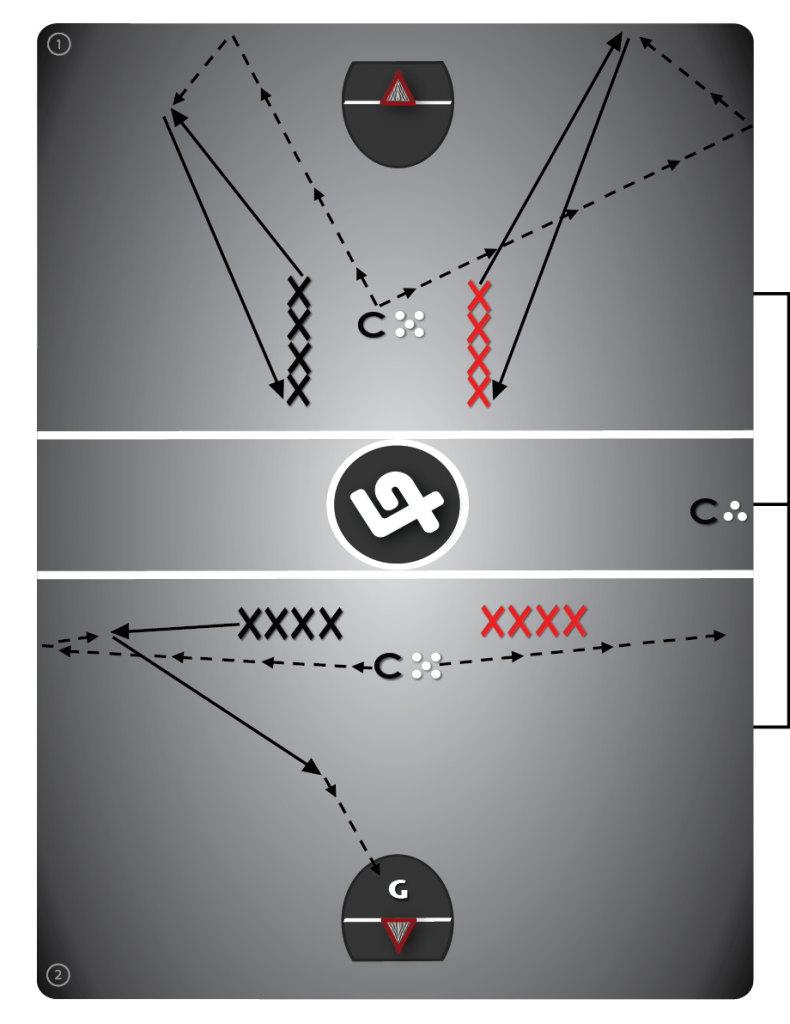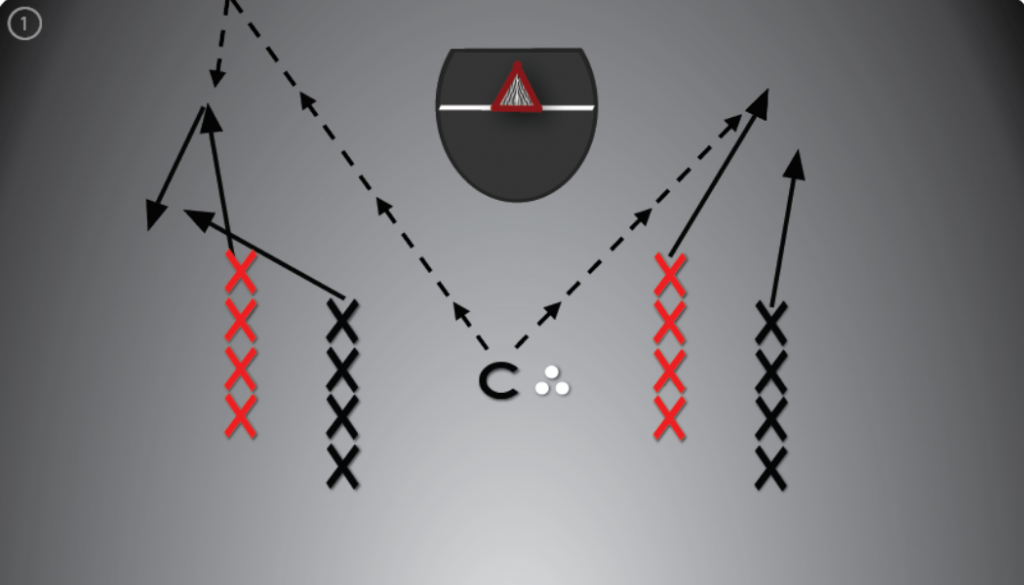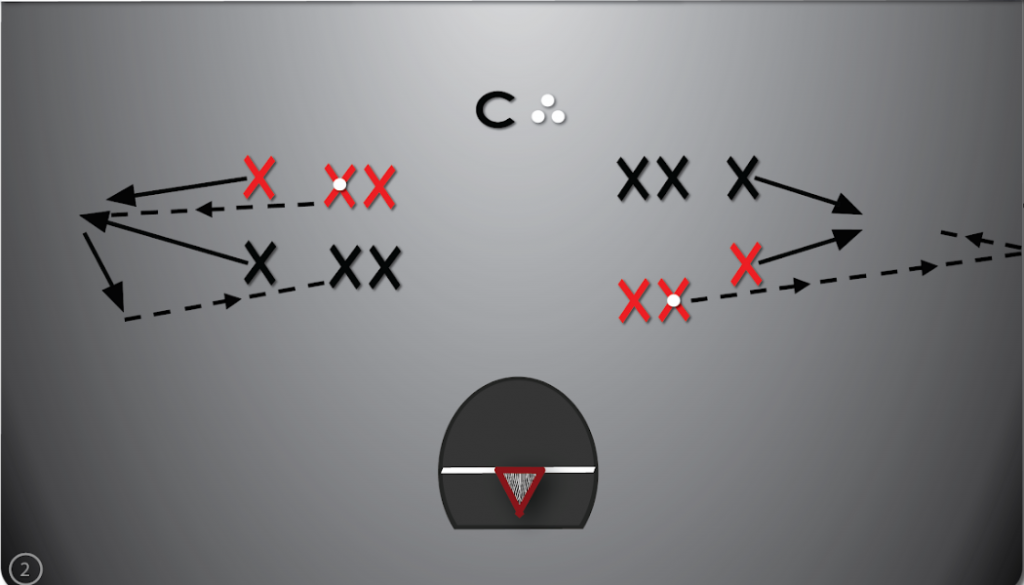Beginner Lacrosse Drills: Loose Balls
Assuming the basics of scooping through the ball, trapping & scooping, “scoop-tuck & turn,” and “scoop to triple-threat” have been covered off in both static and dynamic fashion (as seen in our “Basic Practice Plans,” the next step is to start preparing players to get loose balls in traffic (against an opponent). Little nuances such as boxing out, “keeping it alive” for a teammate to come in and scoop it, other times poking at, kicking or batting the ball to gain an advantage, all come into play; all of which are worthy of drills in and of themselves!
Being “two hand tough” on loose balls means keeping two hands on the stick even when you know you are about to take a slash across the forearms
Drill #1: “Stationary/Dynamic Loose Balls”
As a Warm-Up prior to all out competing with an opponent, players can practice several variations of stationary (Variation #1 - Top Diagram Below) and dynamic loose balls, depending on their skill level. To recreate the feel for “scooping through” a loose ball in traffic, players can eventually pair up, with one partner putting their stick flush behind the ball as the other partner comes in and scoops through the ball/stick (Variation #2 - Bottom Diagram Below). After picking it up they can practice tucking it in and running to open space, afterwards setting up the same situation for their partner to practice. Players could also practice knocking the stick out of the way and boxing-out, then trap & scooping the ball and getting their hands up into the triple threat position. There are many combinations of loose ball skills and situations you could practice. Another more advanced variation is having one player ready to scoop a loose ball while the other tries to poke at their bottom hand, in an effort to interrupt their rhythm.
Drill #2: “Loose Balls - Sans Pressure”
We have thus far started our drill series on a continuum building up from stationary, to pursuing loose balls with no pressure, eventually getting to the speed and pressure of a real live 50/50 loose ball battle. The drill below could be skipped for more skilled players, but for beginners it is perfect for practicing Attacking Loose Balls with speed as they are coming off of the boards, and protecting it once you’ve got it. After the player corrals the loose ball they should run it back towards the middle of the floor and put it into the pile in front of the coach, which represents what you would do after collecting a loose ball in the defensive end of the floor (Variation #1 - Top Diagram). The goal of the drill is to get lots of reps of full intensity loose balls, reacting to them upon first sight (coach is standing behind players).

Variation #2 (Bottom Diagram) is similar in orientation but represents a loose ball near the offensive end of the floor. Players get the loose ball off of the side-boards instead of the corner, collecting the loose ball and running quickly to the net for a shot (representing a broken play in the neutral zone). It also adds a bit of a fatigue element to the subsequent loose balls (and shots), which will be harder to execute successfully as the drill goes on.
Drill #3: “Loose Balls With Pressure”
Next, consider adding a real live element of pressure (Variation #1), whereby two players go into the corner for the loose ball, with one player having a head start over the other. The player trailing the play should stay close enough where if the player ahead of them misses the ball they can attempt to get it, but otherwise applying pressure on the player as they attempt to clear it out of the “defensive zone.” Players should explore different match-ups so they get to go against players with the same and different measures of the size, speed and strength.

Variation #2 changes the location of the loose ball to an area of the floor that requires less spatial awareness (i.e. no crease), but also adds the element of having to pass the ball back to the next person in line behind you in line, mimicking a support pass while Breaking Out up the floor (scoop-to-triple threat). Players also begin side-by-side this time, with one of the players behind them rolling the loose ball in to start the play.

Drill #4: “Loose Ball Battle”
Lastly have players compete for 50/50 balls, which means players are starting side-by-side on each side of the coach, with the coach behind the players who are facing the corners. Upon first sight of the ball, players run into the corner and “battle” for the ball. Whoever comes up with it can either run it out of the drill, otherwise they may be given a chance to explore playing some one-on-one for 5 seconds, before sending a ball into the opposite corner.
Advance to 2 vs. 2, which requires players to work in tandem, and utilizes a lot more finicky maneuvers, which should be the focus in drills moving forward. The Box-Out Drill for instance, is especially important for players in these types of tight quarters, helping differentiate from what may otherwise be called as minor interference if performed incorrectly. Loose ball battles should frequently be re-hashed upon throughout the course of a season, ensuring that effort and physicality on loose balls is always high in any drill performed moving forward.
CONCLUDING THOUGHTS:
At the end of the day, the team that wins the most loose ball battles usually ends up winning the game. More loose balls (also known as “ground balls” in field lacrosse) translates into more possession, which usually effects other variables such as: momentum, multiple re-sets, shot totals and fatigue. The biggest determining factor in getting a loose ball is hard/effort, which generally comes from developing your anaerobic capacity off the floor; and having the will to compete. Battling to keep the ball alive for a teammate is sometimes just as important as picking the ball up for oneself. The best loose ball players have a 6th gear they can kick it into and somehow come out of a corner with the ball against two opponents. They simply want it more.
0 Comments